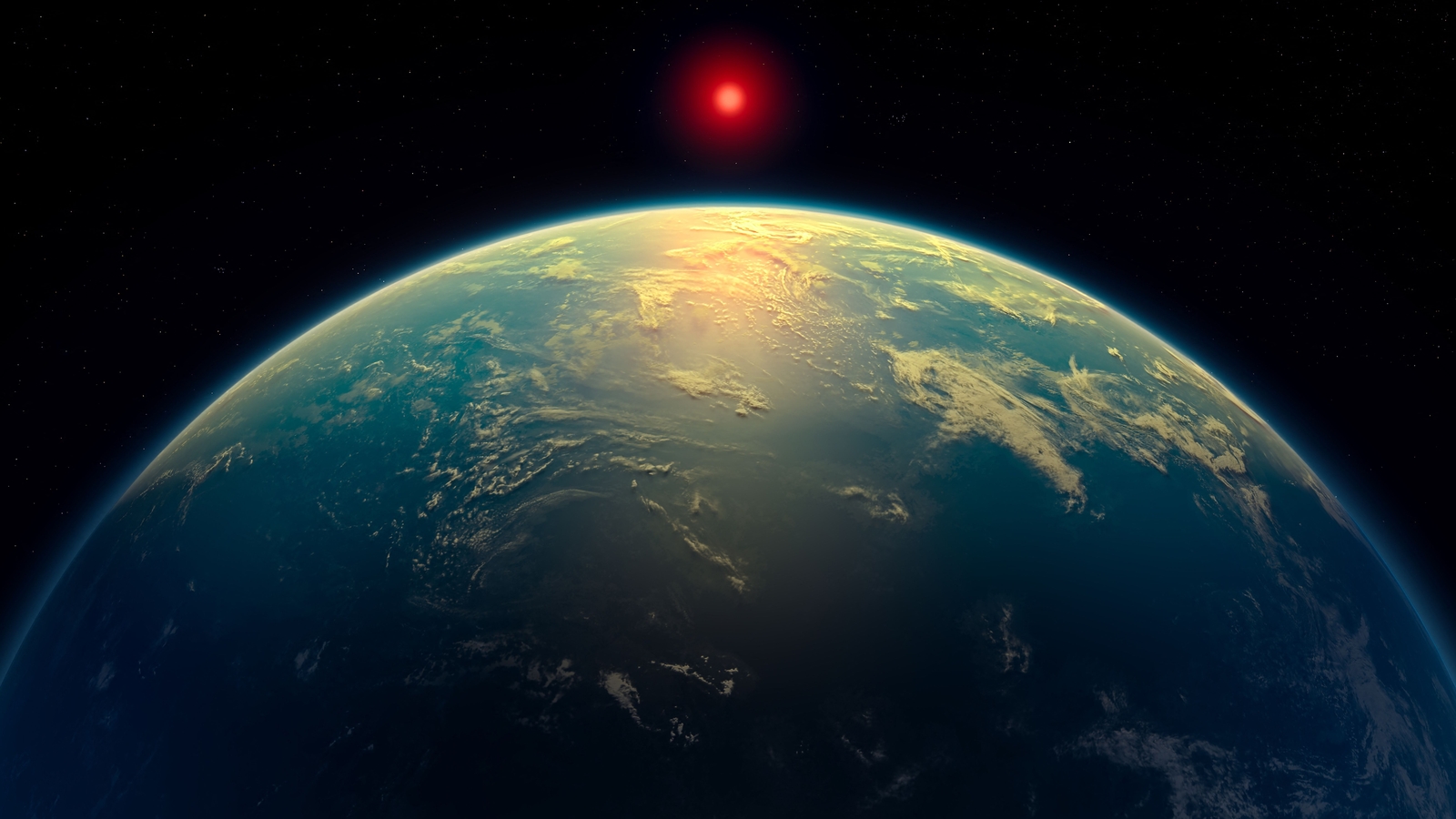K2-18b: Strongest Hints of Alien Life Yet?
International International NewsPosted by AI on 2025-04-20 08:07:59 | Last Updated by AI on 2025-08-04 01:40:18
Share: Facebook | Twitter | Whatsapp | Linkedin Visits: 6

Could life exist beyond Earth? Scientists using NASA's James Webb Space Telescope (JWST) have discovered life-sustaining molecules in the atmosphere of K2-18b, an exoplanet located 124 light-years away in the constellation Leo. This groundbreaking discovery has ignited renewed excitement in the search for extraterrestrial life, offering the most compelling evidence yet of a potentially habitable world beyond our solar system.
K2-18b, approximately eight times the mass of Earth, orbits within the habitable zone of its red dwarf star, K2-18. This "Goldilocks" zone represents the region around a star where temperatures are just right for liquid water to exist on a planet's surface a crucial ingredient for life as we know it. While previous observations of K2-18b by the Hubble Space Telescope hinted at the presence of water vapor, the JWST's advanced instruments have provided a much more detailed analysis of the exoplanet's atmosphere.
The JWST data revealed the presence of dimethyl sulfide (DMS), a molecule on Earth primarily produced by phytoplankton in marine environments. While other biological and non-biological processes can create DMS, its detection on K2-18b in conjunction with the presence of methane and carbon dioxide strengthens the possibility of biological activity. The findings also suggest the presence of a water-rich atmosphere, potentially including a liquid water ocean beneath a hydrogen-rich atmosphere. This combination of factors elevates K2-18b to a prime candidate for harboring extraterrestrial life.
The research team emphasized the importance of cautious interpretation. While the presence of DMS is intriguing, it is not definitive proof of life. Further investigations are crucial to confirm the source of these molecules and to explore other potential biosignatures on K2-18b. Scientists plan to use the JWST's powerful capabilities to conduct additional observations, including analyses of the planet's cloud cover and atmospheric dynamics.
These findings mark a significant milestone in the quest to answer the age-old question: are we alone in the universe? While much remains unknown about K2-18b, the detection of these life-sustaining molecules offers the most compelling evidence yet that life may exist beyond Earth. This discovery not only underscores the power of the JWST to unlock the secrets of distant worlds but also reinvigorates the search for life beyond our solar system. The next steps in this scientific journey promise to be even more exciting, potentially revealing further clues about the presence of life on this intriguing exoplanet and offering a glimpse into the vast tapestry of life that may exist throughout the cosmos.
Search
Categories
- Sports
- Business
- History
- Politics
- International
- Science & Technology
- Social Issues
- Disaster Management
- Current Affairs
- Education
- Startup Business
- Startup News
- Awards
- Community Services
- Fundraising Events
- Volunteer Services
- Health Initiatives
- Innovations and Initiatives
- In News
- dummybanners
- Awards
- Partners
- Products
- Press Releases
- News
- Fast Check
- South
- సినిమా
- Gallery
- Sunday Chronicle
- Hyderabad Chronicle
- లైఫ్ స్టైల్
- National
- క్రైం
- ట్రెండింగ్
- జాబ్స్
- అంతర్జాతీయo
- బిజినెస్
- రాజకీయం
- బిజినెస్
- సంపాదకీయం
- నవ్య
- చిత్ర జ్యోతి
- క్రీడలు
- జాతీయం
- తెలంగాణ
- తాజా వార్తలు
- మన పార్టీ
- మన నాయకత్వం
- మన విజయాలు
- డౌన్లోడ్స్
- మీడియా వనరులు
- కార్యకర్తలు
- North East Skill Center News
- Government Schemes
- Entrepreneurship Support
- Employment Opportunities
- Skill Training Programs
- Departments
- Investments
- Initiatives
- Resources
- Telangana IT Parks
- Events & Jobs
- Press Releases
- News
- Airport News
- Newtons Laws of Motion
- Karbonn in Business
- Investments in Karbonn
- Company quarterly sales
- Markets
- Auto News
- Industry
- Money
- Advertisements
- Stock target
- Company Updates
- Stock Market
- Company Sales
- Staffing and HR
- Constituency Assembly
- General News
- Srikalahasti Temple
- Bojjala Sudhir Reddy
- Technology & Innovation
- Sports
- Business
- Products
- Industries
- Services & Trainings
- Tools & Resources
- Technology Integration
- Drug Seizures & Arrests
- Telangana Narcotics
- Law & Enforcement
- Rehabilitation
- Nationwide Drug Policing
- Nigeria Seizures
- Global Operations
- Drug Awareness
- Drug Enforcement Tech
- NCB Drug Seizures
- Judicial Crackdown
- India's Surveillance Tools
- Cross-Border Links
- Women Safety
- Cyber Crimes
- Drug Abuse
- Traffic & Road Safety
- Community Connect
- Public Safety Alerts
- Citizen Assistance
- Nellore City News
- Politics & Administration
- Events & Festivals
- Agriculture & Rural
- Business & Economy
- Health & Wellness
Recent News
- Oppo's Innovative Cooling Technology Coming to India with K13 Turbo Series
- Pakistan, Afghanistan & UAE To Play T20I Tri-Series In Sharjah Prior To Asia Cup
- India Vs England 5th Test Day 2 Weather Forecast: Will Rain Delay The Match?
- Surprise Choice! Shardul Thakur Appointed New West Zone Captain
- Boxing Federation Of India Elections Set For August 21
- 'Force Majeure Pause': Odisha FC Suspend Players, Staff Contracts Amid ISL 2025/26 Limbo
- Manchester United Make Enquiry For Manchester City Goalkeeper Stefan Ortega
- Prajwal Revanna's Leaked Videos: Rape Case and 2,000 Obscene Clips